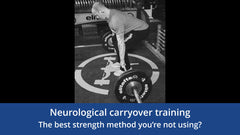Neurological Carryover Training: The Best Strength Method You’re Not Using?
Neurological carryover training (NCT), also referred to as progressive range of motion (PRM) training, is a strength-training method that has been around for decades and yet seems to have disappeared from the current training landscape.
Paul Anderson was likely the first person to use this training method. For the back squat, he would take the weight that he wanted to achieve at the end of his training cycle and suspend it from chains in his barn so that he only needed to move it an inch or two. As the weeks went on, he would adjust the chains to lower the bar until he was squatting it through his full range of motion (ROM) at the end of the training cycle.

His setup for the deadlift was even better. He would have a bar outside—again loaded with just a little more than his current max—and he would dig a hole under the center of the bar. At the start of the cycle, he would start with a hole deep enough that when he stood in it he only needed to lift the bar an inch or so to lock it out. Then as the training cycle went on, he would fill in the hole to increase the ROM until he was lifting it as a traditional deadlift.
Was it pretty? Probably not, but you can’t argue with the results. Among the many incredible feats of strength Paul Anderson is attributed with are a 1,200-pound squat and a 1,000-pound deadlift (using deadlift hooks to help him grip the bar). While it’s possible some of his feats of strength may have been exaggerated, the number of lifts at which he exceled (and how far he was ahead of the rest of the lifting world at this time) has to put him up there as one of the strongest humans to have ever lived.
Put simply, an NCT training cycle will involve you taking a load that is just a little bit higher than your current max (the smaller the increase over your current max, the better) and progressively lifting it over a larger ROM as the weeks progress. This increase in ROM can be done using pins, chains, boards, or boxes, depending on the lift. The smaller the increase in ROM from week to week, the smoother your progression will be and the more likely that the cycle will bring good results. In general I don’t like to program an NCT cycle over fewer than 10 weeks, unless we are dealing with a very small increase over the lifter’s current max.
So, what are the benefits to this method? Well, there are a lot, but these are the biggest ones in my opinion:
- Regular exposure to supramaximal loads desensitizes the Golgi tendon organs (GTOs). GTOs are one of the body’s natural protective mechanisms. Think of these as the hand brake on your force production. The more we desensitize them, the more that hand brake comes off and the more of our max force production we will be able to use.
- It results in an increase in firing rate. Once we have recruited all possible muscle fibers, the only way we can produce more force is by increasing the rate at which the fast-twitch fibers twitch. This is only achieved with heavier loads, like those the NCT system allows us to use week in and week out.
- It increases postural strength and active stability. Moving maximal (or, in this case, supramaximal) loads requires a very high degree of postural strength and stability to maintain the required alignment, even if the ROM is small. By spending a lot of time supporting these supramaximal loads, we improve this ability under the specific conditions of while supporting maximal loads.
- It increases lifter confidence. Many lifters get nervous about attempting a weight that they haven’t touched before. With the NCT system, you lift your end-of-cycle personal best every single week, usually for multiple reps. This allows the lifter to habituate to the load and gain confidence with it.
- It allows lifters to lift maximally on a regular basis without burning. Most strength athletes enjoy lifting heavy. . . . funny that. However, lifting maximally all the time will often lead to form degradation, issues with joints and soft tissues, or neurological fatigue. If you have a lifter who is always driven to lift heavy, the NCT system allows them to do this in a progressive and sensible manner without burning themselves out.
- It’s fun. This factor should not be underestimated. A lifter who enjoys their training and has fun doing it is much more likely to train hard and do so consistently. NCT training for a lot of lifters will be a completely new stimulus and will provide a breath of fresh air in their training.
The list could go on and on. This is why the NCT method is probably my favorite of all the methods that Christian Thibaudeau and I cover in The Overload System for Strength.

Latest Posts
- A Guide for Fitness Professionals: Dr. Barbara A. Bushman on Fitness Professional’s Handbook, Eighth Edition
- Single-leg vs. double-leg training for athleticism
- Fountain of youth for athleticism: Lifting, sprinting, or jumping?
- Cause-and-effect connection between physical activity and specific outcomes
- The science of getting stronger without weights
- BODYBUILDING ANATOMY


